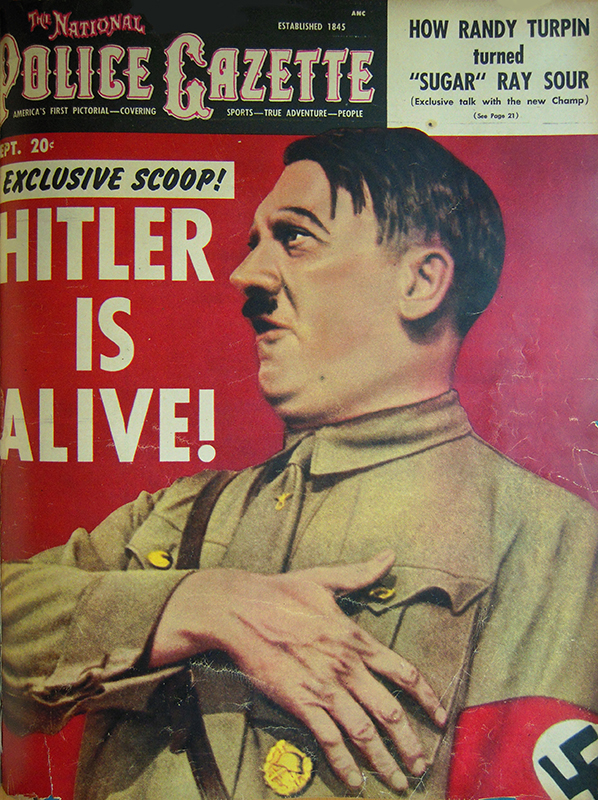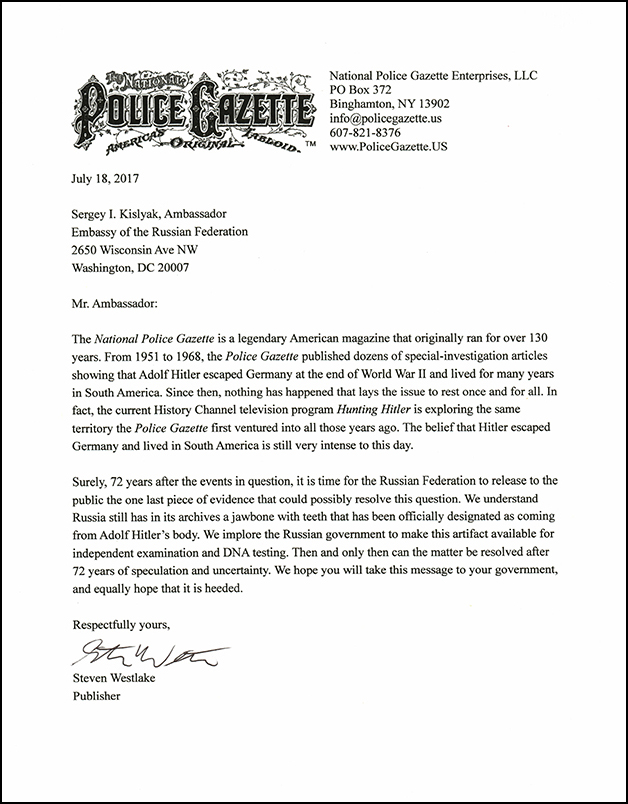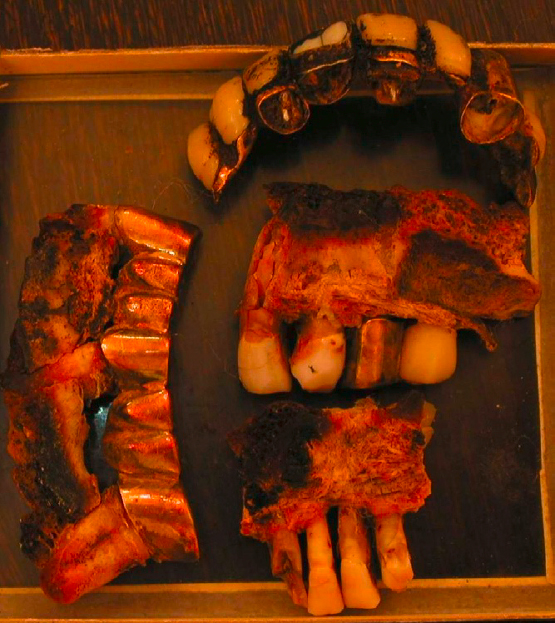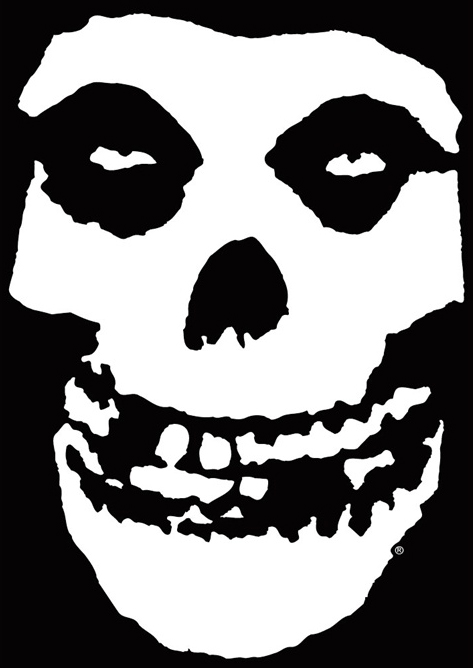One Last Piece of Hitler-Suicide “Evidence” to be Debunked.
Police Gazette Calls on Russian Federation to Release Hitler’s Jawbone.
The first two seasons of the History Channel show Hunting Hitler have done a spectacular job of demonstrating not just how Adolf Hitler could have escaped Germany at the end of World War II, made it to South America, and lived there in secret for many years, but also how many top-ranking Nazis did exactly that.
Beginning in 1951, the National Police Gazette became the first major news outlet to propose the same thing. So with the third season of Hunting Hitler set to air late this year or early next, we’d like to address the one bottleneck yet remaining in the scenario of Hitler’s escape: the activities in and around the Führerbunker in late April and early May of 1945.
 The first salvo in the Police Gazette’s “Hitler Is Alive” series appeared in the September 1951 issue.
The first salvo in the Police Gazette’s “Hitler Is Alive” series appeared in the September 1951 issue.
Let’s review: Adolf Hitler escaped Germany at the end of World War II and lived for many years in South America. One of the facts that leads us to this conclusion is there is no evidence proving otherwise.
The one possible piece of evidence that could maybe lay the question to rest is a chunk of jawbone with real teeth that the Russians claim they recovered from Hitler’s body in May 1945, though they never publicly said so until 1968. This item has a 72-year chain-of-evidence problem that might be insurmountable. But even so, it—and accompanying artificial dental work—is the last remaining piece of physical evidence that’s being used as proof Hitler died in Berlin in 1945. As such, the Police Gazette is calling on the Russian government to finally release the jawbone and teeth so they can be independently examined and DNA tested. If the Russians are so sure they are Hitler’s, what do they have to lose?
 Our letter to the Russian embassy requesting release of the Hitler jawbone.
Our letter to the Russian embassy requesting release of the Hitler jawbone.
Until then, we are left with the investigations conducted by the Police Gazette from 1951 to 1972, and those conducted currently by Hunting Hitler, that reveal it wasn’t just possible but likely Hitler escaped.
For 23 years after the end of World War II the Russians were cagey when the subject of Hitler’s body came up. At times they would even say they never found a trace and considered him still alive. The Police Gazette, of course, took that ball and ran with it through the end zone, into the clubhouse, and out of the stadium. So maybe it was 17 years of unrelenting “Hitler Is Alive” exposés by the Gazette that finally got the Russians to throw in the towel and say in 1968 that, yes, actually they had found Hitler’s body on May 4, 1945, two days after they entered the Reich Chancellery. And not only that, they performed an autopsy on it on May 8th. And not only that, they located two of Hitler’s dental workers, got descriptions of his dental work, and had him positively identified by May 11th. Case closed.
So with everything buttoned up, they did the next logical thing: bury the body at an address about 70 miles west of Berlin. But wait, there’s more. Two years after the shocking revelation that they had Hitler’s body all along, the Russians decided to completely incinerate it and scatter the ashes. Or maybe not completely. Maybe they saved pieces of the jawbone and a piece of the skull. In 2000, they put on a public exhibit of the items. The skull piece was there. But there was only a photograph of the jawbone and dentures, which were deemed important pieces of evidence that must remain protected.
 The items claimed by the Russians to be Hitler’s real teeth, jawbone, and false teeth.
The items claimed by the Russians to be Hitler’s real teeth, jawbone, and false teeth.
Then in 2009, the skull piece was sent to the United States for DNA testing, and—is anyone surprised—was shown to not only NOT belong to Hitler, it belonged to a woman about 30 years old. So then we’re told, “Okay, that one was found outside the bunker in 1946. So it’s possible it wasn’t Hitler’s.”
After all this, we’re left right back at the beginning. No physical evidence, just the word of the Russians who had 23 years to reverse-engineer a jawbone with natural teeth and various dentures and constructions based on Hitler’s known dental records and interviews with dental staff who’d spent upwards of 10 years in Soviet prisons. Meanwhile, Hitler’s chief dentist Hugo Blaschke was released by the Americans in 1948, but died in 1959, well before the release in 1968 of the Russian bombshell. He’d provided descriptions of Hitler’s teeth, but had never been asked to directly view the Russian evidence.
This is to point out the inherent unreliability of anything released by the Russians, but especially Soviet Russians, and most especially Stalinist Soviet Russians. Some folks might not remember that Josef Stalin and the Soviet Union were Kim Jong Un and North Korea. Their main forms of communication were deception, unreliability, and belligerence. To take their word for anything without independent examination of physical evidence is just a non-starter.
So with that piece of non-proof out of the way, we turn to the other source pointed to by those who support the suicide theory: the large number of witnesses who knew about or were in the area of the alleged suicide—though nobody actually saw it happen. For the following timeline we make use of Hitler’s Last Day Minute by Minute by Jonathan Mayo and Emma Craigie, themselves supporters of the suicide theory.
In the days prior to the event, Hitler was going around telling everyone in sight he was going to commit suicide. At 1:30am on April 30th—the fateful day—he tells “about 25 guards and servants.” At 2:00am he tells a group of doctors and nurses. At 2:45pm he tells a group of secretaries and “other staff members.” Of course, he’s already informed his closest aides and assistants: Martin Bormann, Heinz Linge, Otto Günsche, Joseph Goebbels, etc. But why would it have been necessary to personally tell so many other people unless the object was to establish a cover story for when these people eventually got captured and interrogated, most likely by the Russians?
So if a fake suicide was planned, when might a switch have taken place? In 1951, the Police Gazette turned up indications that a live double had been substituted the evening before who had been subjected to a procedure called a “silk-cord operation” by Hitler physician Dr Ludwig Stumpfegger, the same doctor who would later administer lethal doses of cyanide to the Goebbels children. Upon further analysis, the most likely point of the switch is at the moment of the “suicide.” The farther back a switch takes place, the larger the number of people who would have had to be complicit and/or the more convincing a double would have had to be during meetings with top generals and aides. It would work best if no one was required to lie under interrogation and the double was already dead.
However, just by way of logical exercise, if anyone in the bunker were brought into the scheme, Linge would have been the first choice, followed by Bormann and Günsche. Bormann is a special case who will be dealt with later, but Linge and Günsche were both captured by the Russians and spent 10 years in custody. If the two of them had any knowledge of Hitler’s faked suicide, you can bet the Russians would have gotten it out of them. Which leads to an interesting side issue. Suppose Linge and Günsche were in on the scheme and subsequently spilled the beans to the Russians. Would the Soviet Russians under Josef Stalin have taken that information and run with it to the British and Americans? Not on your previous existence! To this day it is common Russian practice to hold any proprietary information close to the vest. If they knew—and the other Allies didn’t—that Hitler was still alive it would have given Russia an intelligence and geopolitical advantage they would not have blown by making that knowledge public. Then, during the course of their 10 years as Russia’s guests, Linge and Günsche would be coached about what to say when they were returned West—not unlike what actually did happen with Hitler dental workers Kaethe Heusemann and Fritz Echtmann. Their usefulness would be greater as repatriated citizens of West Germany, spreading the gospel of Hitler’s suicide, than in remaining prisoners in Russia.
In the end, however, if Linge and Günsche had been in on the plot it’s very unlikely they would have been allowed to remain in a position where they’d be captured. The last thing Hitler would want is for Stalin, himself the psychopathic leader of a country that just lost tens of millions of its citizens to the Nazi invasion, to be turning over every rock on earth looking for him. Linge and Günsche would have either been killed or themselves provided with a safe route of escape.
So the most likely scenario goes like this: At 1:30pm—exactly two hours before Hitler’s supposed suicide—the bunker’s switchboard operator Rochus Misch spots in a hallway of the Chancellery above the bunker the head of the Gestapo Heinrich Müller with two “high ranking” SS officers. He fears they are there to “silence” any witnesses to the coming suicide—Hitler himself has already told over three dozen people that’s what he’s planning to do. But no silencing ever takes place. The reason for Müller and the officers’ presence is never explained. Müller is seen in the area of the bunker again the following day. Then he is not seen. And he is never seen again.
The Gestapo, which was a division of the SS, was Nazi Germany’s secret police, specializing in security and counterintelligence. The SS as a whole was Hitler and the Nazis’ domestic-military protection and security force. If anyone in the country knew the safest routes and safest places at any given moment, it was Müller and high-ranking officers of the SS. If anyone in the country knew how to secretly move dead bodies in and live bodies out, it was Müller and high-ranking officers of the SS. And here they were, showing up two hours before Hitler’s planned “suicide” and then disappearing the following day, never to be seen again.
Therefore, with the planning and assistance of the Gestapo and SS, the switch happens at 3:30pm on April 30th. With Hitler and Eva Braun set to bite their respective cyanide capsules at the same time, it would not have been difficult for him to trick her into biting hers while he remained alive. With Eva gone, the Hitler lookalike is brought in, possibly already dead. In discussions with one of his physicians Dr Werner Haase, Hitler had decided on a very odd method for his and Eva’s suicides. She was to simply bite on the cyanide capsule. But he was to bite on a cyanide capsule at the same moment he shot himself in the head. Cyanide is very effective and instantly lethal. Why bother with the literal overkill of also a gunshot to the head? If Hitler had been so concerned with not leaving parts of himself that could be used as trophies, why take an unnecessary step almost guaranteed to leave your blood all over the room?
One effect of cyanide is it causes the face to contort, making the person look not quite like who they usually are. It’s likely the double had been given cyanide not just to kill him but to contort his face and chalk up any lack of resemblance to the real Hitler to the effects of the poison. Then the gunshot is most likely a signal that the switch has been made and it is time to move to the next steps. The real Hitler has been spirited away by the time Linge and Bormann enter the room at 3:40 or so. Linge, who was closest to the body, later said he did not even look at Hitler’s face before wrapping him in a blanket.
Besides Linge and Günsche, Martin Bormann was the closest to Hitler prior to the Führer entering his study for the “final” time as well as after the “suicide” took place. Bormann, of course, disappeared after escaping the bunker the following day. Artur Axmann, a member of his party who was captured by the Russians, claimed to have last seen Bormann dead near Lehrter train station. But no body was found. The Police Gazette subsequently turned up evidence Bormann was living in South America, a situation the film Willy Wonka and the Chocolate Factory had great fun with by having Bormann, as a “Paraguayan gambler,” claim to have found the fifth golden ticket. Even more magically, Bormann’s remains turned up near the train station in 1972, after 27 years of searches found nothing. There were traces of soil on the skeleton that were not common in that area of Germany. But this is all a subject for another article.
One final direct eyewitness at the time of the “suicide” was Magda Goebbels, mother of the six children who were about to be killed. She was allowed to see Hitler briefly just after he entered his study. But the next day she committed suicide with her husband Joseph, so no testimony from her was possible.
So here we are. All the relevant testimony and documents that we have are unreliable. But there is one piece of alleged physical evidence, the jawbone with teeth. If real, this is the one item that could provide incontestable proof that Hitler died. However, because of the number of years that passed between April 1945 and when its existence was revealed, not to mention the number of years between then and now, the question of when and where Hitler died might remain open regardless. And that, as well, would be the subject of another article….
 Hitler’s Führerbunker study almost exactly how it looked in April 1945.
Hitler’s Führerbunker study almost exactly how it looked in April 1945.
Visit Amazon and get all the Police Gazette‘s original “Hitler Is Alive!” reporting collected together in one place.


 Muhammad Ali and the Beatles meet as both were on the verge of taking over the world. After this photo shoot, Ali called the Beatles “sissies.” Very talented sissies.
Muhammad Ali and the Beatles meet as both were on the verge of taking over the world. After this photo shoot, Ali called the Beatles “sissies.” Very talented sissies. The first salvo in the Police Gazette’s “Hitler Is Alive” series appeared in the September 1951 issue.
The first salvo in the Police Gazette’s “Hitler Is Alive” series appeared in the September 1951 issue. Our letter to the Russian embassy requesting release of the Hitler jawbone.
Our letter to the Russian embassy requesting release of the Hitler jawbone. The items claimed by the Russians to be Hitler’s real teeth, jawbone, and false teeth.
The items claimed by the Russians to be Hitler’s real teeth, jawbone, and false teeth. Hitler’s Führerbunker study almost exactly how it looked in April 1945.
Hitler’s Führerbunker study almost exactly how it looked in April 1945.
